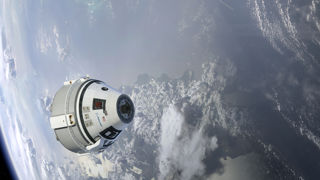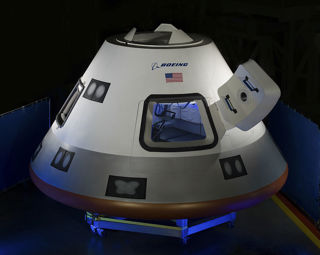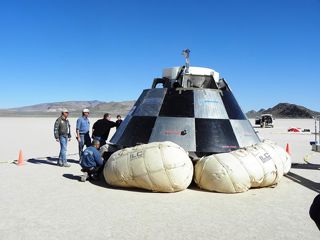
Boeing Starliner
- 6th Jun 2024
- Author: Catherine Muller and Mike Darch
-
![Starliner Spacecraft approaching the International Space Station.]()
NASA Travelling to space is no easy task and the clock is ticking for Boeing’s Starliner. With its final crewed test flight being the last hurdle to clear before Boeing are given the green light to routinely ferry crew to the ISS and back, will the spacecraft reach the stars or will Boeing’s long overdue Starliner experience further delays?
The Starliner Project
The CST-100 Starliner (Crew Space Transportation) is a reusable spacecraft developed by American aeronautics company Boeing. Designed to be used by NASA to send astronauts to and from low Earth orbit (LEO) and the International Space Station (ISS), this is Boeing’s first commercially developed space capsule.
Starliner forms part of the Commercial Crew Program (CCP) - NASA’s project aiming to increase collaboration between the space agency and American commercial space companies. Competition for the contract began in 2010 and Boeing were selected in 2014.
At the same time as awarding funding for Starliner, the CCP also awarded funding for SpaceX’s Crew Dragon spacecraft, which has successfully been flying crewed missions since 2020. Find out more about SpaceX and the CCP in this blog about SpaceX’s crewed Dragon flight.
By selecting two different American companies, NASA hopes to build domestic redundancy and resilience in its crewed LEO space programs.

Why Boeing?
Founded in 1916, Boeing is a multinational corporation specialising in aeronautics. Manufacturing all sorts, from airplanes to rockets and satellites, Boeing have historically been among the largest aerospace manufacturers in the world. In fact, Boeing have been working with NASA since its inception, and played a crucial role in the Apollo program, working on the Saturn V rocket and the Apollo Command and Service Module.
NASA and Boeing have a long and exciting history, and in 2014 NASA awarded Boeing $4.2 billion to develop the CST-100 Starliner, a reusable spacecraft that can carry up to seven astronauts, or a combination of astronauts and cargo, up to the ISS, by 2017.

Starliner Test Flights
After missing the initial target of a 2017 launch, Boeing’s Starliner has been put through three test flights since 2019, each with varying degrees of success.
The first of these was a pad abort test in November 2019. Only 95 seconds in duration, this flight was designed to test Starliner’s abort systems, imperative for ensuring astronauts on board would be safe in case of an emergency. The spacecraft was able to successfully pull away from the launch tower and return to Earth, but only two of the three parachutes on board were deployed. Despite this, the mission was deemed a success.
Orbital tests
Following this was the first Boeing Starliner Orbital Flight Test (Boe-OFT). It launched on 20 December 2019. Carrying Rosie the Rocketeer (an anthropomorphic test device) on board, this mission aimed to spend eight days in space, dock with the ISS and return to Earth. However, once again, the capsule ran into trouble, as it failed to reach the desired orbit for rendezvous and docking with the ISS. As a result, the mission was aborted after two days. The spacecraft did return successfully to Earth, but further testing was required to prove Starliner’s capability before a crewed launch.
The next test, Boeing Orbital Flight Test 2 (Boe OFT-2), was originally scheduled for August 2021, but after issues with the spacecraft’s propulsion system, it was delayed. Almost two years after the partial failure of Boe-OFT, Rosie the Rocketeer once again donned her flight suit and was strapped into the Starliner capsule and on 19 May 2022, Boe OFT-2 was finally launched. This time Rosie made it all the way to the ISS, with Starliner successfully docking with the space station two days after launch. It remained docked for four days and returned to Earth. The success of this mission paved the way for the first crewed test flight of Starliner.
Crewed Test Flight
Starliner still has one final hurdle to overcome before it becomes fully operational. This is the Boeing Crewed Test Flight (Boe CFT) and was scheduled for launch no earlier than July 2023, but has been delayed several times from then.
The mission eventually launched on 5th June 2024 on a United Launch Alliance Atlas V rocket from Space Launch Complex-41 at Cape Canaveral Space Force Station in Florida.
Instead of Rosie the Rocketeer, this flight was crewed by commander Barry Wilmore and pilot Sunita Williams. Both experienced NASA astronauts, Wilmore and Williams will spend approximately seven days in space as part of this mission, and the spacecraft will once again dock with the ISS. If all goes as planned, In the process Williams became the first woman to fly on the maiden crew of an orbital spacecraft type.
According to NASA and Boeing, this short trip to space will provide enough time to certify that the CST-100 Starliner can meet its test objectives, the most important of which is that it can safely fly astronaut crews to and from the ISS.
Beyond the Test Flights
Boeing will now set its sights on its first operational spaceflight. Depending on the results of the crewed flight test, the spacecraft could be deemed ready for regular flights as early as November 2024, with the first operational mission —Starliner 1— expected to launch in the spring of 2025.
Boeing has been contracted by NASA for six operational flights to the ISS with Starliner.
However, if there are further delays, NASA has already contracted SpaceX for an additional eight spaceflights aboard Crew Dragon as a contingency plan. So, alongside the 14 contracted flights from SpaceX, NASA should have sufficient support in transporting crew to the ISS through 2030.
It's a crucial test flight for the multinational aerospace company, as any errors in the Boeing CFT may jeopardise the future of the Starliner project, one which has already seen over half a decade of delays.

As we enter a new era of space exploration, space agencies around the world are turning to commercial partners and collaboration for the development of new technology for upcoming missions. Now is not the time to be left behind, and all eyes are on Boeing Starliner’s to see if it can overcome the years of setbacks and secure its future in space.
Full references / credits:
(Banner) A rendering of Boeing's Starliner, set to begin flying to the International Space Station. Credit: Boeing
(1) Starliner Spacecraft approaching the International Space Station. Credit: NASA
(2) Logo for NASA's Commercial Crew Program. Credit: NASA
(3) Starliner spacecraft (fully outfitted CST-100 mock-up). Credit: Robert Markowitz (public domain)
(4) Launch of Boeing Pad Abort Test, November 2019. Credit: NASA
(5) Rosie the Rocketeer, an anthropomorphic test device used on board Boeing Orbital Test Flights 1 and 2. Credit: Boeing
(6) Boeing Crew Flight Test (CFT) astronauts Butch Wilmore and Suni Williams in T-38 pre-flight activities. Credit: NASA
(7) Launch of Boeing Orbital Test Flight 2, May 2022. Credit: United Launch Alliance
(8) Personnel inspect the CST-100 following the parachute drop test. Credit: BLM Nevada CC BY 4.0 DEED https://www.flickr.com/photos/blmnevada/7091257463/






